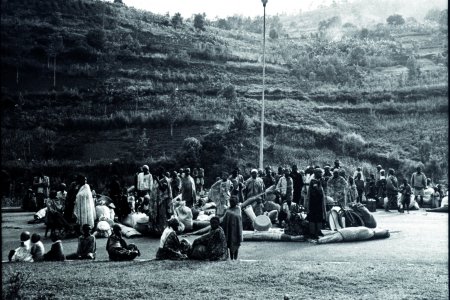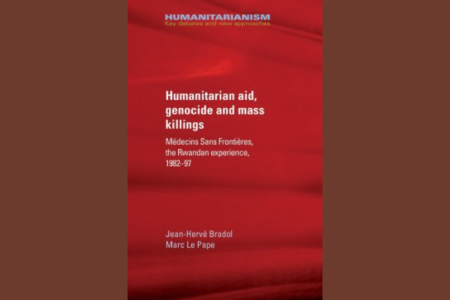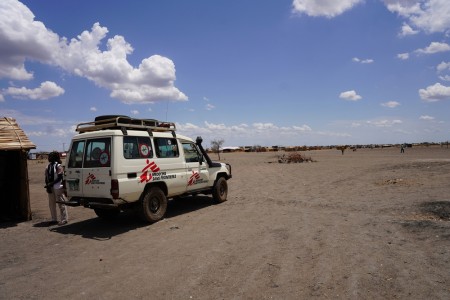
From War To Genocide: Criminal Politics in Rwanda 1990–1994; Humanitarian Aid, Genocide and Mass Killings: Médecins Sans Frontiéres, The Rwandan Experience, 1982–97
Bert Ingelaere
Book review published in Canadian Journal of African Studies
- From War To Genocide: Criminal Politics in Rwanda 1990–1994, by André Guichaoua, Madison, USA, University of Wisconsin Press, 2015, Ix + 416 pp.
- Humanitarian Aid, Genocide and Mass Killings: Médecins Sans Frontières, The Rwandan Experience, 1982–97, by Jean-Hervé Bradol and Marc Le Pape, Manchester, UK, Manchester University Press, 2017, x + 146 pp.
Although much has been written about the 1994 genocide in Rwanda, two recent volumes offer fresh perspectives and add considerable insights. Guichaoua’s From War to Genocide: Criminal Politics in Rwanda 1990–1994 takes the reader deep into the belly of the beast. The book describes and analyzes the real politics of the politics of genocide based on extraordinary detailed evidence with respect to the strategies and tactics of key military and political players. Bradol and Le Pape’s Humanitarian Aid, Genocide and Mass Killings: Médecins Sans Frontières, The Rwandan Experience, 1982–97 offers a unique understanding of the consequences of this murderous political game from the point of view of humanitarian aid workers in general and the NGO Doctors Without Borders (Médecins Sans Frontières – MSF) in particular.
At times political thriller, at times personal witness, From War to Genocide is above all a rigorous historical account of one of the biggest tragedies of the twentieth century. Guichaoua combines his deep understanding of the Rwandan cultural, economic and socio-political context – building on scholarly expertise as well as a vast network of sources acquired before the 1990s – with the insights he developed as expert witness for the International Criminal Tribunal For Rwanda (ICTR).
The book contains thirteen chapters and a conclusion. The first six chapters cover the period preceding 6 April 1994, the moment the presidential plane was shot over the skies of Kigali, an event immediately followed by the start of the killings. This first part of the book is about political power and how (not) to share it. Rwanda’s political landscape fragmented with the introduction of a multiparty system (chapter three) and the start of the civil war with the Rwandan Patriotic Front (RPF) in October 1990 (chapter two). A multitude of actors jockeyed for power, previously exclusively held by a single political party, the Mouvement Révolutionnaire National pour le Développement (MRND) and, in particular, the presidential clan hailing from the north of the country. Chapters three, four and five deal with the socalled Arusha negotiations and agreements. Interestingly, Guichaoua’s rich information allows for a detailed analysis of the fissures, differences and shifting alliances within what are often considered to be monolithic blocs of actors.
In reality, there was a “third” and a “fourth” force, one aligned with the “hardliners” of the mouvance présidentielle, the other aligned with the RPF, each situated at opposite ends of the political continuum. The only thing they had in common was their opposition to the Arusha Peace Accords. (70)
In the background of this first part looms the question that stands at the heart of the chapters (seven to twelve) that follow: was there a plan to commit genocide? In fact, Guichaoua comes to the conclusion that planning – for instance in analogy to what is known about the Holocaust – did not exist in the case of Rwanda. This is the most revealing and controversial claim of the book since it challenges the dominant narrative on the origins and execution of the genocide against Tutsi. That narrative suggests that the extermination of the Tutsi has foundational dimensions dating back to colonial influences and Rwanda’s independence in the 1960s. This genocidal project reached its organizational climax in the early 1990s with all the necessary ingredients: propaganda, training of militia, distribution of weapons, mobilization of the population and the identification, separation and extermination of the targeted group. Instead, Guichaoua concludes: “In fact, leaving aside partisan arguments and a posteriori evidence, it is difficult to demonstrate the existence of a genocidal ‘conspiracy’, to delineate stages in its unfolding, and to specifically identify its participant and practical organization” (231– 32). Evidently, the author does not claim there was no genocide but he takes aim at the questions of “conspiracy” and “planning”. In doing so, he follows the main thrust of the legal reasoning of the judges at the ICTR where key figures like Colonel Bagosora were convicted for genocide crimes but not for (conspiracy in) its planning. Why? “If the theory of the masterminds appears so weak today, it is because the day-to-day genocide was the product of multifarious decisions that cannot be traced back to a single ‘proponent’ or to a timeless project” (303). And this is what the book lays bare to the bone, namely how a combination of what are contingent factors came together in a complex political chess game that ultimately resulted in a policy of genocide.
Bradol and Le Pape allow the reader to perceive the unfolding of this policy of genocide and its aftermath “through the eyes of field teams’ members” (1), meaning the teams of humanitarian aid organizations. Also here, the book can be read from different angles: it’s a political sociology of aid organizations, a contribution to the historical record of the genocide and mass killings that engulfed central Africa in the 1990s and, foremost, an invitation to reflect on the ethical challenges at the heart of humanitarian intervention. The authors make their objectives clear from the start:
How to comprehend, in the midst of an emergency, the political and social dynamics unique to each situation of extreme violence? How to avoid falling victim to or becoming accomplices of criminal forces? How to remain effective in such situations? (13) They aim to answer these question by mainly relying on available archives of MSF and personal testimony of humanitarian aid workers.
The book has four chapters, an introduction and conclusion. The first chapter provides the historical background with a discussion of the genesis of the Rwandan Patriotic Front in Uganda’s refugee camps. This chapter also deals with the unfolding of the genocide policy. In line with the authors’ objectives, all of this is discussed from the perspective of humanitarian aid workers. A central concern is whether, why and how decisions with huge ethical ramifications were made:
The dilemma was as simple as it was cruel: agree to support the work carried out in these facilities [hospitals and camps] at the risk of being caught up in spiral of violence or refuse to work and deprive those trying to survive there of outside help. (32)
A key notion emerging in this first chapter is the camp; to no surprise since humanitarian work is closely tied with refugees and displaced people who are generally grouped together in camps in times of mass violence. The camp is therefore also omnipresent in the chapters dealing with the aftermath of the genocide. Chapter two focuses on the work of humanitarian organizations in the vast camps in Tanzania and the Democratic Republic of Congo (Zaïre at the time) where millions of Rwandans had sought refuge fleeing the genocide and, mostly, the advancing RPF troops. Chapter three shifts attention to the situation inside Rwanda and especially also the camps of internally displaced Hutus but also pays attention to the situation in prisons and the efforts to contribute to rebuilding the country’s health infrastructure. Chapter four deals with the violent emptying of the camps in the Congo and the flight of refugees deep into the forests of the Congo.
Two important observations emerge from these chapters. First, humanitarian aid agencies – despite their claims of neutrality – need to take decisions of a deep political nature. Does one assist refugees in the camps bordering Rwanda knowing that the leadership that had executed the genocide had a considerable influence over the camps’ population and their organization (chapter two)? Does, and how does, one speak out against the massacre of several thousands of people by RPF forces and the increasing repression inside Rwanda knowing that the new power holders wielded considerable international influence for having halted the genocide (chapter three)? How not to be misused by military actors hunting down refugees in the dense forests of the Congo (chapter four)? Second, although it’s not their main task, humanitarian aid workers are also the record keepers of history. The events described in chapters two, three and four are officially denied – or at least downplayed – by those responsible and have never found a decent international, regional or national response, namely to hold perpetrators accountable or recognize the victims. But the records of humanitarian aid agencies and testimony of their workers makes sure these events did not vanish into thin air.
Both books show how archives – whether from tribunals or aid agencies – are an important tool to thicken the historical record, also for the understanding of mass killings. But here lies also the limitation of both works. The ICTR gathered evidence in order to satisfy specific standards of proof. A tribunal is not a truth commission. And the focus of the humanitarian reports is primarily the victims, their sheer number and whereabouts as well as their health condition. The authors are well aware of these limitations and discuss the strength and weaknesses of their sources and aptly reflect on their shifting roles of researchers, witness or humanitarian.
When you think you understand the unfolding of the Rwandan genocide, read From War to Genocide and you will have to reconsider much of what has become taken for granted. Readers with varying interest will find what they need. The (un)making of peace agreements, Rwanda’s political culture, how genocide policy develops, the passage à l’acte in cases of mass violence, the definition of genocide or the working of international criminal tribunals, the book covers a vast terrain. When you think the work of the staff of humanitarian aid agencies is pretty straightforward, namely saving lives, read Humanitarian Aid, Genocide and Mass Killings and you will start to appreciate their complex navigation of what Primo Levi called the grey zone of saving while equally being part of doing harm. The book is an invitation to further develop this awareness and provide some clues for doing things differently for upcoming complex emergencies around the globe.
To cite this content :
Bert Ingelaere, “From War To Genocide: Criminal Politics in Rwanda 1990–1994; Humanitarian Aid, Genocide and Mass Killings: Médecins Sans Frontiéres, The Rwandan Experience, 1982–97”, 7 octobre 2018, URL : https://msf-crash.org/en/war-and-humanitarianism/war-genocide-criminal-politics-rwanda-1990-1994-humanitarian-aid-genocide
If you would like to comment on this article, you can find us on social media or contact us here:
Contribute


